Using Fire to Restore Illinois Prairies and Woodlands
The Nature Conservancy has made it a priority to use “good fire” to keep native habitats healthy.
.jpg?crop=0%2C0%2C4000%2C2200&wid=1300&hei=715&scl=3.076923076923077)
Prescribed fires help our remaining native habitats—from prairies to forests—flourish, in the Midwest and beyond.
The word “fire” is often followed by an exclamation point. We learn at an early age to think “danger.” The recent rise in severe wildfires, exacerbated by climate change, has put many of us on high alert, fearful of the devastation that fires can bring to the people and places we love.
It may seem counterintuitive, but one of the most effective ways to prevent wildfires from spreading is the regular use of “prescribed fire,” or intentional, controlled burns in natural areas overseen by trained professionals. As explained by Smokey Bear, prescribed fire safely gets rid of combustible material, such as leaf litter and downed branches, which feed and intensify wildfires.
Prescribed fire is the most effective—and most essential—practice of our land management teams. Most of the Midwest’s biodiversity depends on fire to maintain our prairies, savannas and woodlands.
Prescribed fire is also a proven and highly beneficial land management and restoration tool. The Nature Conservancy (TNC) has been using prescribed fire for more than 60 years—with excellent results. Soon after our highly trained crews set fire to the land, the burned landscapes respond with a flush of native plants that attract birds, pollinators and other wildlife. Meanwhile, invasives and undesirable woody shrubs are suppressed, allowing for natural grasslands or mature forests to thrive. Plus, prescribed fire can help reduce tick populations and the leafy ground matter they like to live in.
Fire and Landscapes
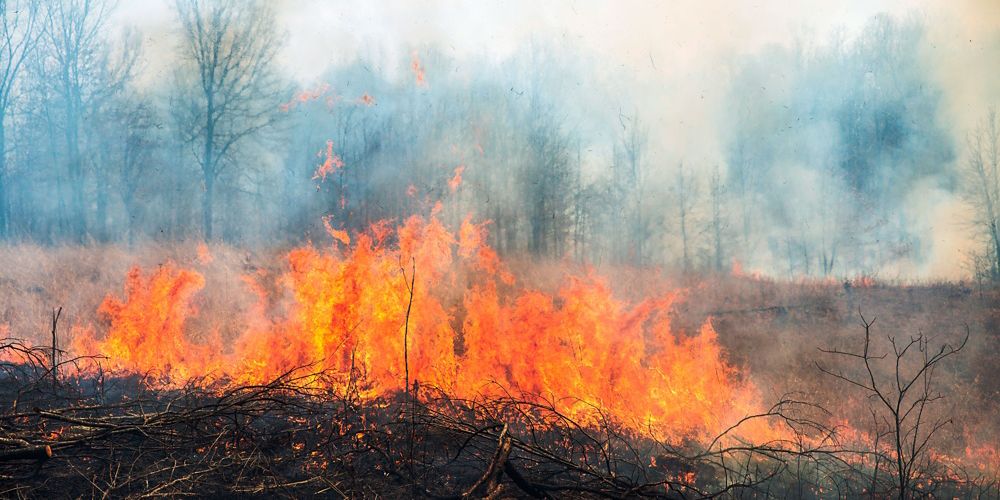
Indigenous Peoples have been using fire across what is now referred to as the Americas since time immemorial. These intentional fires have been and continue to be used to support agricultural and hunting practices, as well as to support plant communities with medicinal, food and cultural significance. It's safe to say that the landscapes of the Americas have been shaped and supported by people and fire for generations.
Turns out these frequent fires were critical to shaping and maintaining most Midwest landscapes. Take prairies as an example. When Midwest prairies go without fire for too long, shrubs and trees start moving in and taking over. This natural succession process, known as the “green glacier” effect, slowly erases grasslands. Invasive species, like buckthorn and bush honeysuckle, speed up and intensify the process, pushing out native plants that many birds, insects and other wildlife need to survive.
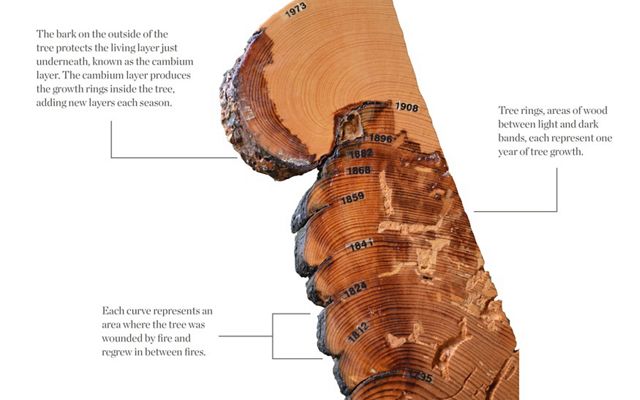

Without fire, a prairie that was once alive with colorful flowers and bird song becomes a dense shrubland clogged with exotic species within a decade or two. This is how we lost most of the remaining prairies in the Midwest that were not already cleared for agriculture or development.
By the late 1800s, fire suppression had become the norm—and the law—as a way to prevent and control wildfires. This mindset lasted until the mid- to late-20th century when scientists, Indigenous Peoples and land guardians like TNC helped demonstrate the essential role of prescribed fire in restoration as well as wildfire containment.
Today, less than 1% of the Midwest’s iconic prairies, savannas and other native habitats remain. By regularly applying prescribed fire, TNC and our partners are helping to ensure the survival of these precious native landscapes—and the wildlife that depend on them. Click each box below to learn more about fire's role in these habitats.
Fire, Wildlife and Native Plants
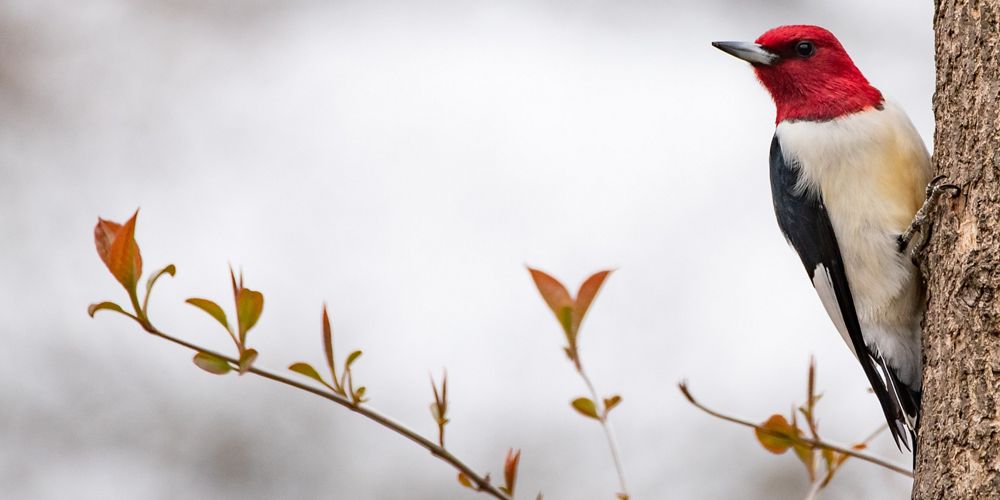
After living with periodic fires over thousands of years, many Midwest species have evolved to rely on regular fires to thrive or even survive. Many native wildflowers and grasses have deep root systems that can extend 15-16 feet or more into the soil. Fire may burn the plants above ground, but they will resprout from their roots after the burn. And some plants like wild lupine or trees like jack pines require heat from fire or sunlight to open up and release seeds.
Pollinators like native, ground-nesting bees also benefit from fire. Bee research in natural areas in southeastern Wisconsin found that these pollinators—and the plants they prefer—were more abundant in areas where prescribed fire was regularly applied, including TNC’s Lulu Lake Preserve. For instance, the rare Andrena uvulariae bee is attracted to bellwort, a small, yellow woodland flower that responds well to fire.
Get nature’s best stories delivered monthly to your inbox with our Nature News.
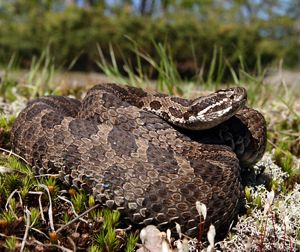
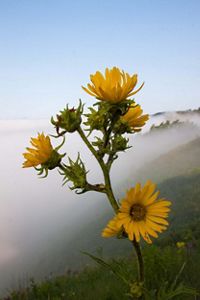
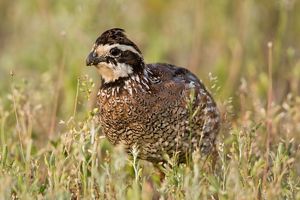

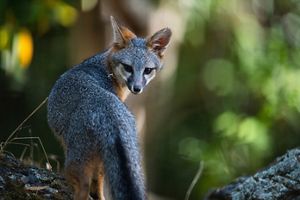
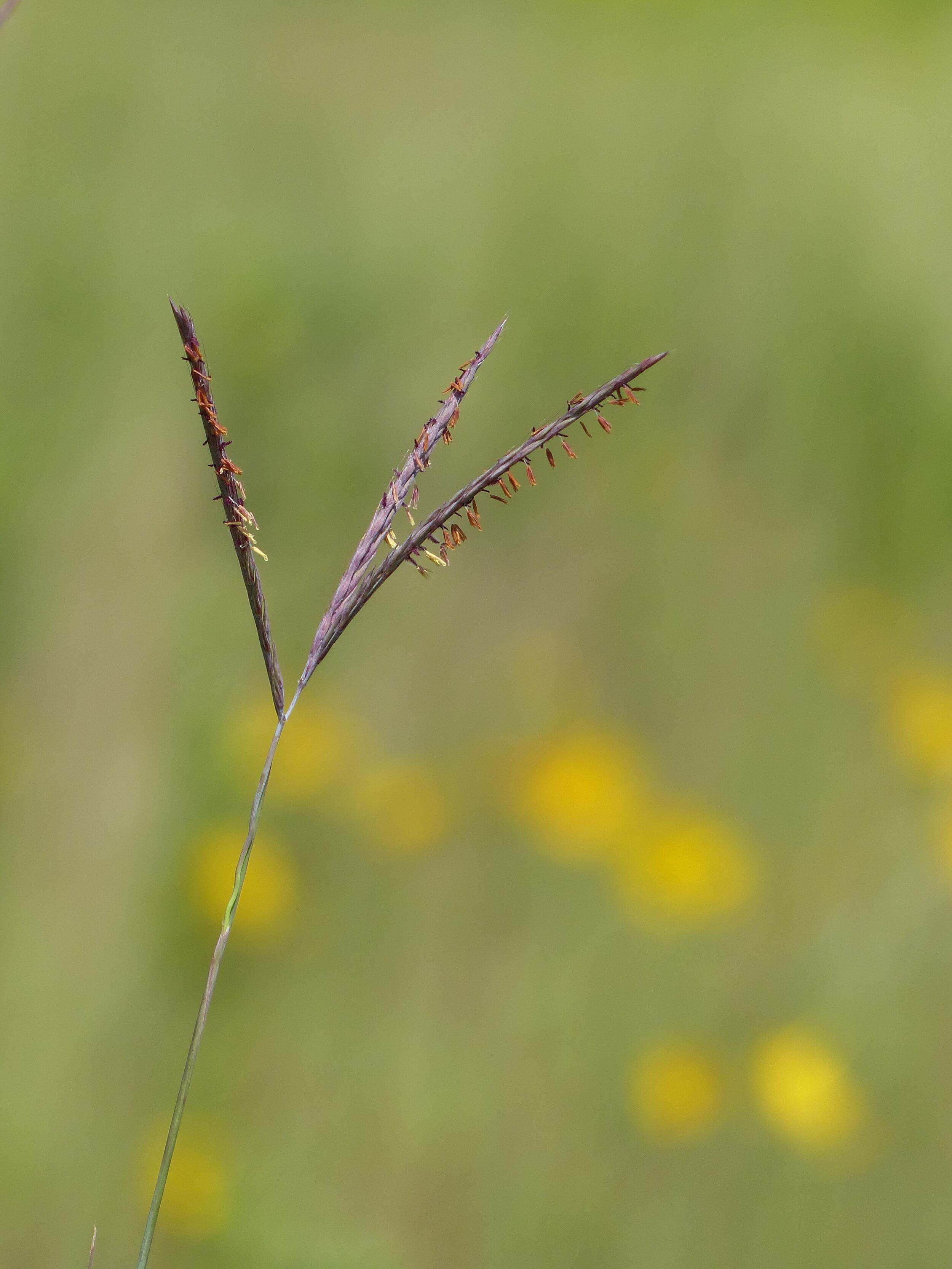

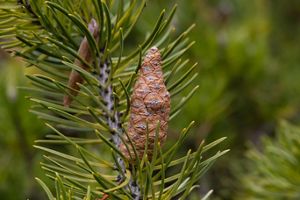
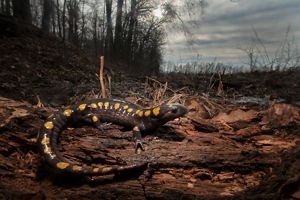
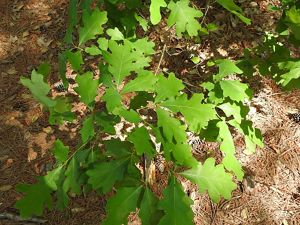

Massasauga Rattlesnake: By reducing dense overgrowth, prescribed burns create cleared spaces for the rattlesnakes to bask, hunt and move between habitats to find mates. © Ryan M. Bolton/Shutterstock.com

Compass Plant: A Midwest native prairie wildlfower, compass plants have deep root systems and have underground growing points, enabling them to survive and thrive after prescribed fire. © Steve S. Meyer

Northern Bobwhite Quail: After fires, bobwhite quail will seek out burned areas for easier foraging and for brooding habitat for their young. © Brady Beck

Northern Pitcher Plant: Controlled burns create reduce competition from invasive plants and create the open, sunny habitats these plants depend on to survive. © Michael Witt

Gray Fox : After prescribed fires, gray foxes can find hunting for their preferred prey of rodents or rabbits easier due to reduced undergrowth in their habitats. © Enrique Aguirre Aves/Adobe Stock

Big Bluestem: In addition to removing invasive species from big bluestem's habitat, controlled burns recycle vital nutrients into the soil, giving this native grass a boost to regrow. © Angie Cole

Kirtland's Warbler: These migratory songbirds only breed in young jack pine forests in Wisconsin and rely on natural fire events to support their nesting sites. © Joel Trick

Jack Pine: A truly fire-dependent species, jack pine needs fire to open its cones and release its seeds, ensuring that the seeds are released in optimal, open, nutrient-rich soils. © Erik/Adobe Stock

Spotted Salamander: Controlled burns can benefit amphibians indirectly, such as reducing the leaf litter that clogs their water sources and lowers oxygen in the vernal pools where they breed. © Michael Wilhelm/TNC Photo Contest 2023

White Oak Sapling: Like many other oak species, white oak thrives after prescribed fire, thanks to reduced competition from other trees and more sunlight reaching the forest floor for saplings. © Scenic Corner/Adobe Stock
As a long-time steward of nature, TNC always considers how wildlife—including birds, animals and plants—will be affected by prescribed fires and tries to minimize any harm to these creatures.
For instance, our fire practitioners schedule burns to avoid mating and nesting seasons and to ensure that smaller reptiles, such as snakes and turtles, are dormant and safely burrowed underground or beneath rocks or logs. Research conducted at TNC’s Nachusa’s Grasslands, in northern Illinois, found that ornate box turtles at that location are almost guaranteed to be underground from Nov. 1 through April 1. Our fire crews use research findings like this to determine the best times to burn habitats where sensitive species of wildlife are living.
“Back-burning”—burning habitats so the flames are slowed down by oncoming winds—gives birds, snakes and other wildlife time to move out of the area. We also leave sections of a burn unit unburned to provide refuges (known as refugia) for insects and plants.
Every fire is planned to keep wildlife safe. Click each photo below to learn how a few species cope with prescribed burns ... and to discover which species is negatively impacted by fire.

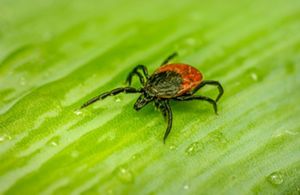

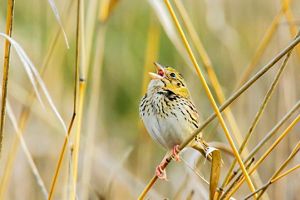

Ornate Box Turtles: Thanks to research done on these turtles at Nachusa Grasslands, TNC burn crews schedule fires in the preserve in the fall when the turtles are dormant underground. © Ryan Rasmussen

Ticks & Fire: Frequent prescribed burns can reduce tick numbers, both by directly killing them and reducing the deep, moist litter layer on the ground they need to stay hydrated. © Erik Karits via Unsplash

Bunny During A Burn: TNC crews conduct burns on relatively small plots of land so that wildlife, like this rabbit hiding during a burn at Nachusa Grasslands, can quickly run to a safe area. © Dee Hudson

Henslow's Sparrow: TNC protects grassland birds like Henslow's sparrows by burning habitats only outside nesting season, using slow, small burns to allow safe escape. © CheepShot/Creative Commons
Expanding Prescribed Fire
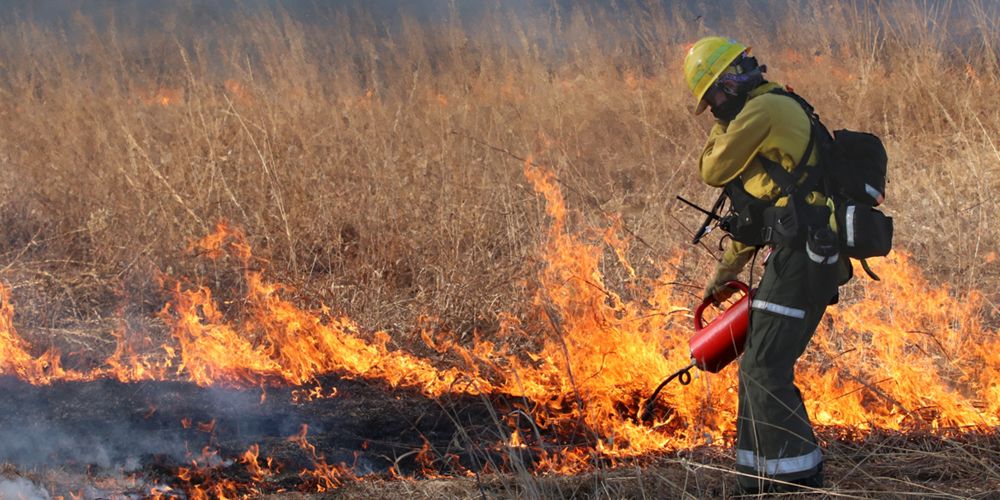
Recognizing the immense benefits of prescribed fire, TNC is working to greatly expand the use of this vital tool. Here in the Midwest, we aim to increase the amount of habitat we burn by 80% to 100% by 2030 across five states: Illinois, Indiana, Michigan, Ohio and Wisconsin.
Prescribed fire can reduce wildfire severity up to 62%
Number of caterpillar species in the U.S. supported by fire-dependent oak trees—a vital food source for birds
Average area, in square miles, TNC burnt in recent years across five Midwest states: Illinois, Indiana, Michigan, Ohio and Wisconsin
Average area, in square miles, TNC aims to burn in the Midwest by 2030—an 80-90% increase
Prescribed fire is now common practice on TNC preserves and lands. To help spread the magic of fire to additional native habitats, TNC fire crews are helping our partners, including government agencies and private landowners, with prescribed fires on their lands.
For instance, since 2014, TNC’s southern Illinois team has been working hand-in-hand with several government agencies—including the U.S. Forest Service, the U.S. Fish and Wildlife Service and the Illinois Department of Natural Resources—to manage prescribed fires in national forests, wildlife refuges and state parks in Illinois, Wisconsin and other states. In 2024 alone, the southern Illinois crew helped burn 18,863 acres on partner sites—which is more than 29 square miles.
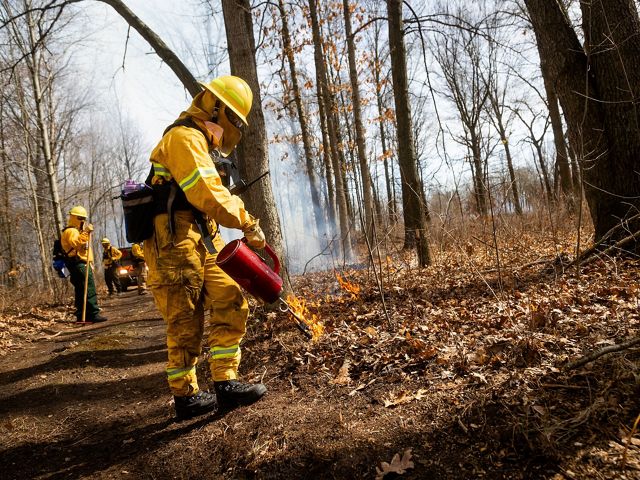
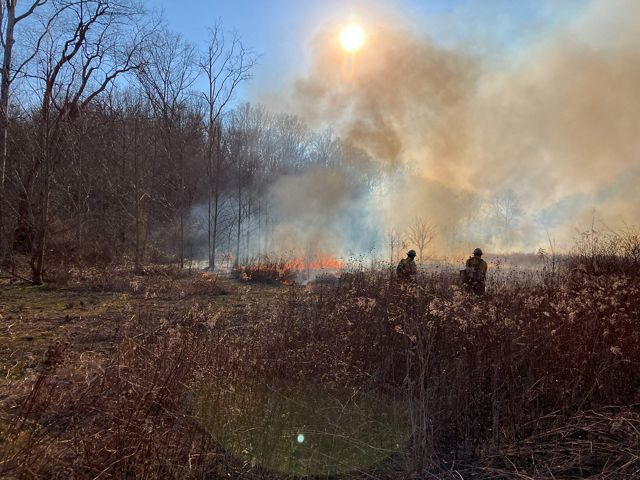
Replicating Illinois’ approach, TNC’s Indiana fire crew helped the U.S. Forest Service treat more than 5,000 acres with fire in Indiana’s Hoosier National Forest in spring 2025. This was about 2,000 more acres than the forest service’s five-year average at Hoosier. “We couldn’t have done it without a lot of help from our cooperators, including TNC, and forest service employees,” said Daron Reynolds, forest fire management officer, Hoosier National Forest, U.S. Forest Service.
A similar partnership is happening in Ohio and Michigan, where TNC has an arrangement with the U.S. Fish and Wildlife Service (USFWS). Brian Winters, prescribed fire manager in Ohio and Michigan, assists with prescribed fires on USFWS public lands in both states, as well as on private lands of USFWS partners. In turn, USFWS fire crews help with prescribed fires on TNC preserves.
In the Midwest, the best seasons to conduct safe, effective prescribed burns are spring and fall when habitats are most receptive to fire. That only adds up to about eight to 12 weeks per year—a short window of opportunity. Troublesome weather, such as high winds or drought conditions, can further limit the number of good fire days.
To get around these challenges, TNC fire crews are now traveling around the Midwest to put prescribed fire on the ground when they are not busy in their home states. For instance, fire seasons naturally end earlier in warmer, southern parts of the Midwest than in the northern parts. Taking advantage of this, our crews in southern Illinois head up to help with fires in Wisconsin or Michigan after they wrap up their burn seasons.
By bringing more crew members to prescribed fires, we are able to strategically burn more acres. For instance, instead of burning only 20 acres with a small crew, we can burn 200 acres across two prescribed fires with a large crew.

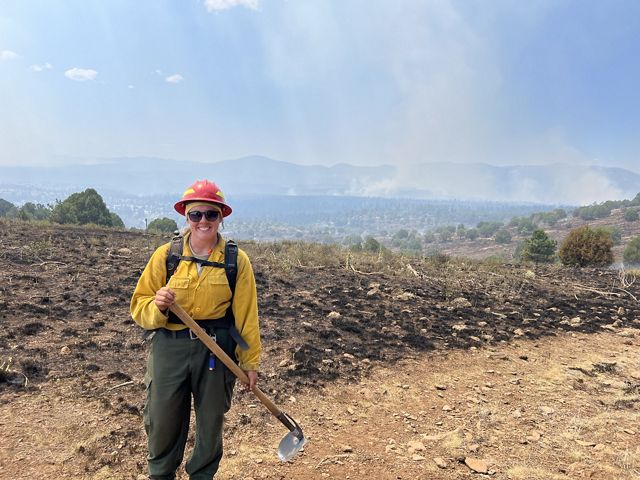
Our mobile fire crews can also work around bad weather. For instance, a planned burn day in southern Wisconsin may be canceled due to high winds. Rather than waiting out the weather, the Wisconsin crew can drive a few hours to Indiana and assist with a burn there.
Every summer, some of our fire crew also travel out west to help fight wildfires. Besides aiding people and nature in danger, TNC crew members get to develop vital fire suppression skills that they also need to safely manage prescribed burns. As many firefighters like to say, “If you light ’em, you better know how to fight ’em.”
Behind the Burn
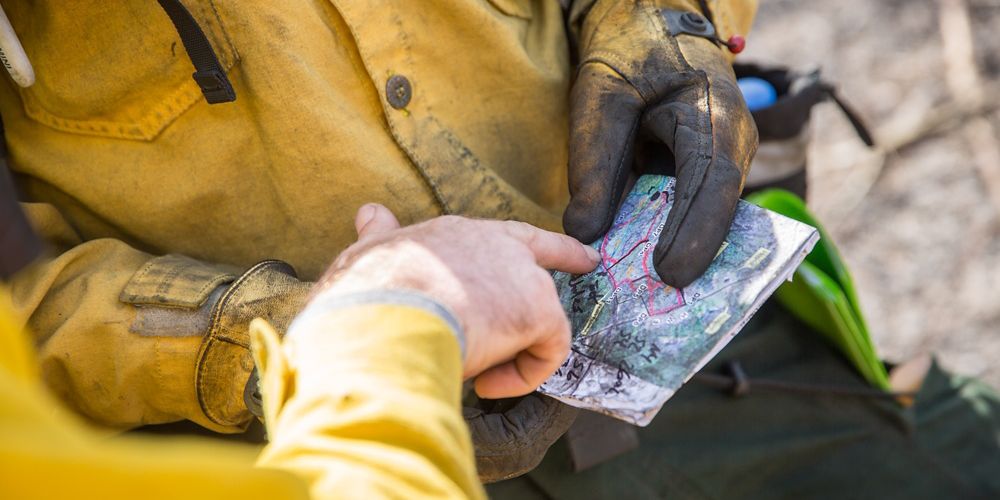
TNC fire managers start planning and preparing for prescribed fires months in advance. Every single detail is thoughtfully considered to ensure we mitigate risk of harm to people, wildlife and properties while also ensuring that the fire meets our goals for revitalizing the habitat.
To become qualified burn crew members or managers, TNC staff and volunteers must go through strenuous training and obtain certifications and licenses to perform specific fire duties.
The exact amount of training and experience required varies, depending on a person’s role on the fire crew. For instance, volunteers and staff interested in assisting a TNC fire crew can do so after completing 40 hours of training. Then they can work their way up, assuming more responsibilities, by obtaining additional training and certifications. In comparison, fire managers who supervise our crews typically have 10-15 years of training and experience in a variety of fire scenarios. It’s the equivalent to the amount of know-how required of surgeons.
I really love passing along my skills and knowledge to beginning fire practitioners. I enjoy teaching about prescribed fire, from demonstrating how to use chainsaws to explaining how we prep the area. It’s really great to see people who are new to fire have those aha moments.
Another critical challenge to scaling up prescribed fire is the need for more trained fire crew with deep, wide experience in controlled burns. By traveling to help with fires in different parts of the country, our crews are gaining invaluable knowledge about applying prescribed fire in different habitats, from forests and prairies to wetlands.
To further assist our fire crew, volunteers and partners in gaining needed training and experience, TNC offers several opportunities. One example is the Prescribed Fire Training Exchanges that TNC and our partners organize around the world, providing hands-on fire experience to thousands of people. TNC’s Midwest Division has also started offering hard-to-find training courses that our fire crews need to complete to earn various certifications so they can move up the prescribed fire career ladder.

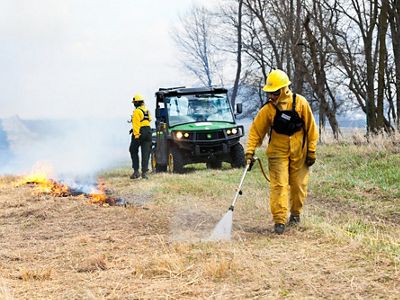
Before, during and after any prescribed fire, TNC crews take steps to anticipate and mitigate potential safety risks that could cause a fire to spread out of control or push heavy smoke into populated areas. Below are a few things we do to ensure the burn is conducted safely.
Before any fire, we create firebreaks around the area we are burning. Firebreaks are strips that have had flammable vegetation removed, which prevents flames from escaping past the area’s boundary. Check Out TNC's Fire Manual
We also consider weather conditions. Sometimes this means we have to postpone or cancel fires if, for example, high winds or droughts make it harder to maintain safety.
Other times, weather can be a friend to our fire crews. For instance, we use the wind to our advantage so that it directs smoke away from roads and residential areas. Evening or nighttime rains can also help us put out fires that we set earlier.
Prescribed fire is more than a management technique—it’s a lifeline for the Midwest’s native landscapes, reviving, restoring and protecting vital habitats. We're building a growing network of fire partners across the region, including fire practitioners, local and state agencies, Indigenous Nations and others to advance the use of prescribed fire. And we're committed to continuing to foster and support innovative, cross-boundary collaborations to advance fire work across the Midwest and beyond.
If this sparks your curiosity, we invite you to join us in keeping good fire alive by exploring more about prescribed fire in your state, advocating for conservation policy or volunteering to help with land restoration efforts near you.
Take a deeper dive into prescribed fire and how TNC is using it in the Midwest and beyond.